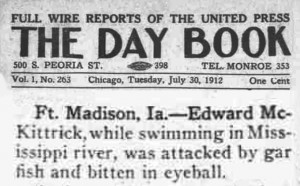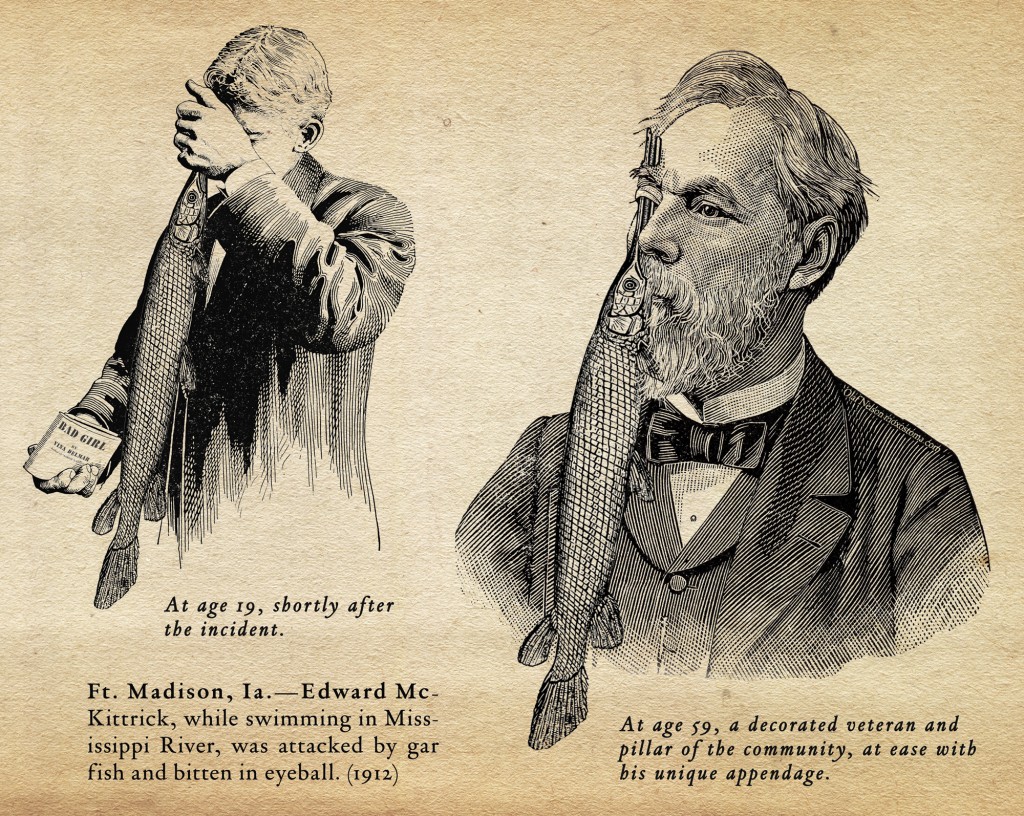Browsing old newspapers for interesting fish stories, I uncovered a very brief item of massive importance and interest. That this has remained hidden so long may be evidence of a cover-up (though there is, as yet, no way to know how high this goes).
There are, in this single sentence, more stories than young Edward himself might have wanted us to find. (See note below about this image of the paper.)
If you have ever seen Jeremy Wade get so worked up over the potential implications of a few sentences of rumored fish-driven carnage that he can spin an entire episode of River Monsters from it before (usually) deciding either that the damage was done by something other than a fish or that it never happened at all, then you know how quickly a story can grow.
This troubling news item is the same.
Was he really swimming? Did he fall in, or was he pushed? Was it really a gar? Could it have been a submerged stick?
What was Edward McKittrick hiding? Who has worked so hard to keep it hidden until now?
Much is missing from this story, but most unfortunate is the absence of an illustration. I tried to find a photo of Mr. McKittrick, hoping for a grizzled river rat with an eye patch, but found nothing. If it’s the same man, I did come up with a birthdate in November 1892, making him 19 when the incident occurred. A prime age for doing dumb things and getting hurt, and a prime age for telling stories to cover your tracks.*
As a public service, I present an artist’s rendering of Edward McKittrick at 19, shortly after his encounter with a vicious Mississippi River gar, and later, when he was a respected pillar of the Fort Madison community. You’re welcome.
I am surprised I have to say this, but messages and comments about the severity and/or impossibility of the injury indicate it’s necessary: I made this illustration. Yesterday. 104 years after the news item was printed. There are no illustrations of the real guy or the real gar. I thought it would be obvious. I mean, who wears a live gar in his eyebrow for 30-40 years?
(To be perfectly clear, the news item is 100% real. Don’t know how true it is, but it is real.)
Added note, April 2021: I apparently have to clarify (see comments) that I absolutely DID photoshop the little news item and the top of the newspaper’s front page into a single image. It wasn’t to trick anyone. I was just being efficient with space. Both parts are real and from the same issue of The Day Book. The notice is on page 30 (https://chroniclingamerica.loc.gov/lccn/sn83045487/1912-07-30/ed-1/seq-30/) and the front page is at (https://chroniclingamerica.loc.gov/lccn/sn83045487/1912-07-30/ed-1/seq-1/).
* I did a little research and found out more about Mr. McKittrick. He registered for the draft for both World War I (when he was 24 and already in the ROTC) and World War II (when he was 49). His WWI draft registration card specifically says he has all his limbs, eyes, etc., but does not mention the gar. He may have been in the infantry during WWI, but appears not to have been deployed outside the US. He was stationed at Ft. Snelling (MN) after he enlisted in 1917, and rose from the rank of Private to 2nd Lieutenant at the time of his discharge in 1919. He died in California in 1966.














After reading this article, I did some research of my own, and, using the newspaper image in this article, I found that the obscure paper title presented is photoshopped and inauthentic (the author’s saying that “the news item is 100% real” is completely false). While there was indeed a newspaper with that name, using the Library of Congress, the particular issue of “The day book” published on July 30th, 1912 did NOT have the title: “Ft. Madison, Ia.-Edward Mckittrick, while swimming in Mississippi river, was attacked by gar fish and bitten in eyeball.” It was actually: “RANK POLICE GRAFT TO BE UNEARTHED IN N.Y.” It was in a completely different font from the one given in this article and was in all caps. In this article, the fake title also appears decently grainier than the upper portion with the newspaper title, which does match with the authentic image given on the Library of Congress’ website. Thus, the image in this article seems to be of a fake title pasted onto the image of the actual July 30, 1912 “The Day Book” issue cover. Disappointing, I personally am a big fan of Jeremy Wade’s “River Monsters” (and highly recommend it to anyone looking for a good show during quarantine), and this certainly does make for an intriguing story! For a link to the Library of Congress’ catalogue of this particular issue, see: https://chroniclingamerica.loc.gov/lccn/sn83045487/1912-07-30/ed-1/. In regards to the historical person of Edward McKittrick, there were several people during that time with that name, and, even if the article were real, I highly doubt any meaningful connection can be made between one of the many people with that name and the man in the fake article. Thus, this article is unfortunately a hoax. However, I must applaud the artistic rendering of this event presented by the author! It is really quite impressive and amusing!
Thanks for compliments. Amusing was the goal. You’re mistaken about the news item, though. It’s was definitely printed. 109 years ago Day Book subscribers probably read it while sitting in the outhouse. As for whether I got the right Edward McKittrick, I don’t know for sure. He fit the information I had, which was almost none. As for “meaningful connection,” this post was just for fun and meaningful was never my intent. I’ve added a note about the Day Book image to clarify that I merged two images.